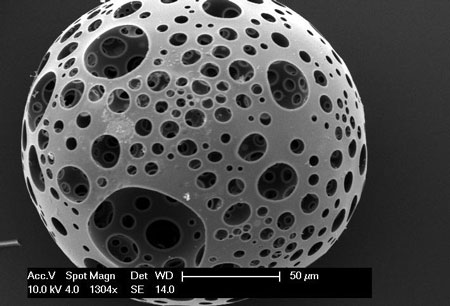I have a longstanding interest in bones partly due to my introduction to a skeleton in a dance course and to US artist Georgia O’Keeffe’s paintings. In any event, it’s been too long since I’ve featured any research on bones here.
This news comes from the UK’s University of Nottingham. A July 25, 2016 news item on Nanowerk announced a grant for stem cell research,
The University of Nottingham has secured £1.2m to develop injectable stem cell-carrying materials to treat and prevent fractures caused by osteoporosis and other bone-thinning diseases.
A July 25, 2016 University of Nottingham press release, which originated the news item, offers more information about the proposed therapy and the research project (Note: Links have been removed),
The experimental materials consist of porous microspheres produced from calcium phosphates – a key component in bones – to be filled with stem cells extracted from the patient.
The targeted therapy could offer a quick, easy and minimally-invasive treatment that is injected into areas considered to be at high-risk of fracture to promote bone regeneration.
The funding grant, from the National Institute for Health Research (NIHR i4i Challenge Award), also supports the development of a prototype delivery device to inject these stem cell loaded microspheres to the sites of interest.
In addition, project partners will investigate how well the materials stay in place once they have been injected inside the body.
Research leads, Dr Ifty Ahmed and Professor Brigitte Scammell explained that the aim was to develop a preventive treatment option to address the growing issue of fractures occurring due to bone-thinning diseases, which is exacerbated due to the worldwide ageing population.
Osteoporosis-related conditions affect some three million Britons, and cost the NHS over £1.73bn each year, according to the National Osteoporotic Society.
Dr Ahmed, from the Faculty of Engineering at The University of Nottingham, said, “We would advocate a national screening program, using a DEXA scan, which measures bone mineral density, to identify people at high risk of fracture due to osteoporosis.
“If we could strengthen these peoples bone before they suffered from fractures, using a simple injection procedure, it would save people the pain and trauma of broken bones and associated consequences such as surgery and loss of independence.”
The NIHR grant will also fund a Patient and Public Involvement study on the suitability of the technology, gauging the opinions and personal experience of people affected by osteoporosis as sufferers or carers, for example.
The project has already undertaken proof-of-concept work to test the feasibility of manufacturing the microsphere materials and lab work to ensure that stem cells attach and reside within these novel microsphere carriers.
The research is still at an early stage and the project team are working towards next phase pre-clinical trials.
This work reminded me of an unfinished piece of science fiction where I developed a society that had the ability to grow bone to replace lost limbs, replace lost bone matter, and restructure faces. I should get back to it one of these days. In the meantime, here’s an image of a microsphere,

A close-up of a injectable stem-cell carrying microsphere made of calcium phosphate which are injected to prevent and treat fractures caused by bone-thinning diseases. (Image: Ifty Ahmed; University of Nottingham)
One final note, fragile bones are no joke but there does seem to be a movement to diagnose more and more people with osteoporosis. Alan Cassels, in his July/August 2016 article for Common Ground magazine, points out that the guidelines for diagnosis have changed and more healthy people are being targeted,
… Americans, the experts tell us, are suffering an epidemic of osteoporosis. A new US osteoporosis guideline says that 72% of women over 65 are considered ‘diseased’ – a number which rises to 93% for those over 75 years old – and hence in need of drug therapy.
What is going on here?
Clearly, the only real ‘epidemic’ is the growing phenomenon where risks for disease are being turned into diseases, in and of themselves. In this racket, ‘high’ blood pressure, elevated cholesterol, low bone density, fluctuating blood sugars, high eyeball pressure and low testosterone, among other things, become worrying signs of chronic, lifelong conditions that demand attention and medication. As I’ve said in the past, “If you want to know why pharma is increasingly targeting healthy people with ‘preventive medicine,’ it’s because that’s where the money is.”
One thing all these risks-as-disease models have in common is they are shaped and supported by clinical practice guidelines. In these guidelines, doctors are told to measure their patients’ parameters. If your measurements are outside some preset levels deemed ‘high risk’ by the expert guidelines, you know what that means: more frequent trips to the pharmacy. The main downside of guidelines is they slap labels on people who aren’t sick and instill in physicians the constant idea their healthy patients are really disease-ridden.
But this is a good news story and if you haven’t sensed it, there’s a rising backlash against medical guidelines, mostly led by doctors, researchers and even some patients outraged at what they see going on. …
I don’t wish to generalize from the situation in the US to the situation in the UK. The medical systems and models are quite different but since at least some of my readership is from the US, I thought this digression might prove helpful. Regardless of where you live, it never hurts to ask questions.